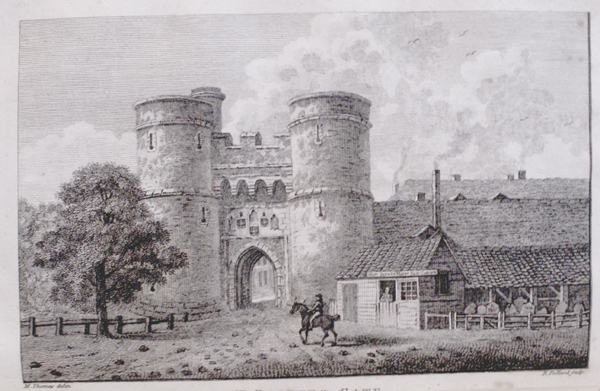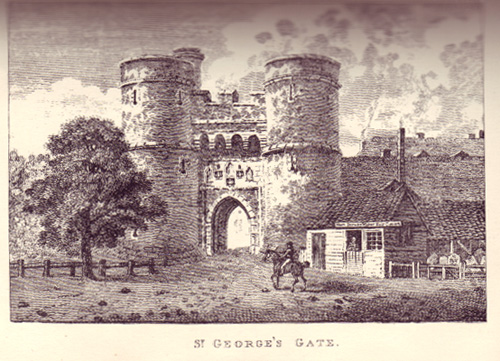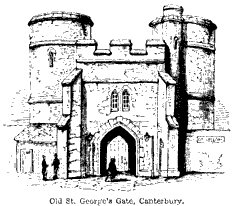
![]()
~ ST. GEORGE'S GATE ~
Also called NEWINGATE or OTE-HILL GATE
CANTERBURY
Demolished 1801-1802
Used to stand in the area of the roundabout just outside of St. George's Street

"ST. GEORGE'S GATE" A drawing from Hasted
"...And another lease informs us that in the reign of Queen Elizabeth there was sufficient water in the city ditch between the said gates* to make it worth while to reserve the fishing rights when the Mayor and Commonalty let the adjoining land. Further we learn that at this date (1586) the Cattle Market (Retherchepe) was held in the neighbourhood of Oaten Hill." Woodruffs List
*St. George's Gate and Riding Gate
In 1800, among the improvements in and near the Cattle-market, the removal of St. George's gate being deemed expedient, the cisterns were then demolished, and a new receptacle for the water formed in the old watch-tower opposite Ivy-Lane; here a large reservoir receives the water, from whence the public cocks are supplied. The destroying of St. George's or, as it is called, Newingate, cannot but be lamented by the antiquary, it being a very handsome and perfect structure, and of such strength and solidity, as bid fair to have been an object of admiration and interest, to the lovers of the works of our fore-fathers for ages yet to come. William Gostling
1488. Newingate is repaired, and partly rebuilt; and, in 1495, 30l. 9s. 7d. are assessed on the several wards, for the further repair of it, and laid out on it that year. Hasted
1536. St. George's gate is the prison for the freemen of the city. Hasted
A.D. 1667, St. George's Gate is made a magazine.

"ST. GEORGE'S GATE" A drawing from Canterbury in the olden time c. 1879 by John Brent
...a little without Newingate, upon Oaten-Hill, the Oat-Market, now the Place of Executing Malefactors (it had a Market Cross) at the meeting of the four Vent-ways, the Market for Cattle called Rethercheap, or the Drove Market, which is still continued, and lastly.....
Magna Britannia Antigua& Nova 1738
Was used as the Gaol for the Freeman of the City.
1785. The large wooden doors at Westgate and Saint George's gate are removed away. Hasted
1787. A bridge, for weighing hay and straw, is erected by the mayor and commonalty, without Saint George's gate. Hasted
1790. An Act of Parliament passes, for making a new road from St. George's gate in Canterbury, to Gutteridge bottom, and for repairing and widening the road from thence to the Dover turnpike road, in the parish of Barham, in Kent. Hasted
"St. George's-gate is also called Newingate, and gives that name to the ward in which it stands, as do the other five gates to theirs respectively. It is built in imitation of Westgate, as Mr. Somner observes, and fortified in the same manner; but when he says Burgate was also portcullised, he seems mistaken, for there is no appearance of that.
Westgate, Burgate and St. George's gate have the arms of Archbishop Juxon on them with those of the Archbishoprick, to which he succeeded at the restoration, and with these new gates repaired the damage done by the Puritans, when they burnt the old ones in 1648."
A walk in and about the City of Canterbury: with many observations not hitherto described in any - William Gostling 1777
"St. George's gate formerly called Newingate, and before that Ote-hill gate, from its leading to that place, was built for a more direct passage into the heart of the city from Dover instead of Ridingate, the more strait and ancient way. It was built about the year 1470, and is a very handsome structure, seemingly in imitation of Westgate, with two noble towers of squared stones. The large reservoirs which hold the water that supplies the city, being in the upper part of it, has preserved this gate from destruction."
Hasted's Historical and Topographical Survey of Kent 1793

"....But to return into the city, through St. George's gate. At a small distance on the right is the parish church of St. George; a little lower, on the opposite side, is the gate-way of the White Friars. Farther on, on the right, are the shambles, which, till the year 1740, stood in the middle of the street; here also is a fish-market, lately established, for the sale of fish, toll-free. Adjoining is a public engine for weighing loads of hay; and near this is the corn-market with a granary over it. This part of the street had a middle row of considerable length, consisting of the shambles, a fine conduit or water house of stone, and the parish church of St. Andrew. The conduit was pulled down in 1754, and the church in 1763; a new church is built just by, which was opened for the performance of divine service December 26, 1773, and consecrated the July following. The Kentish Traveller's Companion 1776
"Another gate, that of St. George, formerly called Newingate (as being the most modern of them all), which was a copy on a smaller scale of Westgate, was built in 1470, and was pulled down in 1801. It had been used first as a prison, next as a storehouse for the corporation, and finally as a reservoir of water for the use of the city. When this gate was condemned to destruction, a carefully executed model in wood was made, with the object of preserving some memorial of it; this is now in the possession of Charles Sandys*, Esq. of Canterbury, who has very kindly permitted us to make the sketch of it which we give at the end of the present article. The chief reason of its demolition appears to have been the want of materials for the formation of the cattle-market." The Archaeological Album 1845
*Critical Dissertation on Professor Willis's "Architectural History of Canterbury Cathedral." By C. Sandys, of Canterbury. 8vo. 2s 6d., published by John Russell Smith ptd. 1846
"Written in no quarrelsome or captious spirit; the highest compliment is paid to Professor Willis, where it is due. But the author has made out a clear case, in some very important instances, of inaccuracies that have led the learned Professor into the construction of serious errors throughout. It may be considered as an indispensable companion to his volume, containing a great deal of extra information of a very curious kind." Art-Union
"St. George's Gate, formerly called Newing-gate, and before that Oathill-gate, from its leading to that place, was built for a more direct passage into the heart of the city from Dover. It was built in the year 1470, and was a very handsome structure seemingly in imitation of West-gate with two noble towers of square stone; reservoirs for supplying the city with water were placed at the top of this gate, which continued to be used until 1801; when, from the narrow entrance of the gate, it was found to be a great obstruction to carriages and inconvenient and dangerous to foot passengers, and the gate was taken down and the materials used for leveling the new cattle market."
Directory 1847
"St. George's Gate, otherwise Newingate or the New Gate, otherwise "Ote Hill Gate," presented considerable similarity to Westgate. As is stood on the edge of the ancient city foss or ditch, there was most likely a bridge attached to it, and thence no doubt the name that the street now bears. St. George's Gate fell victim to the Canterbury innovators. It was removed in 1801-1802 and we give from the Records in a note below the cost of the removal. The summum totum certainly presents an outstanding amount as an expense incurred in pulling down an old gateway. It is a comment upon the doings of a once irresponsible municipal authority. In 1824 the Westgate was very nearly incurring the same fate."
Records April 22, 1801
St. George's Gate ordered to be taken down, and the cisterns to be removed into the yard and tower, part of the city estate in St. Michael's Lane demised to Mr. Faulkner.
October 22, 1802
The surveyor, on the part of the court, presents a bill for the expenses incurred in improvements of the Cattle Market, the taking down of Saint George's Gate, removing the water cisterns, and replacing the same:
Amount - £3820
Allowance for lead and other materials - £283
Total - £3537
Part repaid by sale of estates - £1300
Balance due - £2237
Ordered sale of other estates to meet the same.
Canterbury in the Olden Time, John Brent 1879

St. George's Gate,
or as it was sometimes termed, Newingate and originally Otehill-gate,
was situated at the top of St. George's Street, and was pulled down
a few years since, in order to widen the entrance into the city from
Dover. 1838
directory